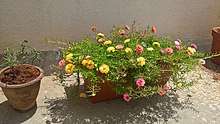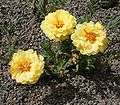Portulaca grandiflora
| Portulaca grandiflora | |
|---|---|
 | |
| Scientific classification | |
| Kingdom: | Plantae |
| Clade: | Angiosperms |
| Clade: | Eudicots |
| Order: | Caryophyllales |
| Family: | Portulacaceae |
| Genus: | Portulaca |
| Species: | P. grandiflora |
| Binomial name | |
| Portulaca grandiflora | |
| Synonyms[1] | |
| |
Portulaca grandiflora is a succulent flowering plant in the family Portulacaceae, native to Argentina, southern Brazil, and Uruguay and often cultivated in gardens.[2][3] It has many common names, including rose moss,[4] ten o'clock,[3] Mexican rose,[3] moss rose,[3] Vietnam Rose,[3] sun rose,[5] rock rose,[5] and moss-rose purslane.
It is also seen in South Asia and widely spread in most of the cities with old 18th- and 19th-century architecture in the Balkans. In Pakistan it is called Gul Dopheri, meaning After Noon Flower, as flowers bloom whole after noon in summer's heat. In Bangladesh, it is called "time fuul", meaning "time flower", because the flower has a specific time to bloom. In India, it is called "nau bajiya" or "9 o'clock flower" as it blooms in morning around 9:00 am. In the Philippines, it is called as "Alembong" as it is charming and grabbing attentions. In Vietnam, it is called "hoa mười giờ" meaning "ten o'clock flower", because the flower is usually in full bloom at 10:00 in the morning. Jarai in Cambodia call it "sun flower". Its buds are often chewed by small birds like the house sparrow.
It is a small, but fast-growing annual plant growing to 30 cm tall, though usually less. However if it is cultivated properly it can easily reach this height. The leaves are thick and fleshy, up to 2.5 cm long, arranged alternately or in small clusters. The flowers are 2.5–3 cm diameter with five petals, variably red, orange, pink, white, and yellow.[2]
Cultivation and uses
Numerous cultivars have been selected for double flowers with additional petals, and for variation in flower color, [2] and it is widely grown in temperate climates as an ornamental plant for annual bedding or as a container plant. It requires ample sunlight and well-drained soils. It requires almost no attention and spreads itself very easily. In places with old architecture it can grow between the stones of the road or sidewalk. Seeds are often sold as mixtures, such as Double Flowering Mixture (see illustrations).
Gallery
 Portulaca Grandiflora bicolour
Portulaca Grandiflora bicolour Portulaca grandiflora in India
Portulaca grandiflora in India Portulaca grandiflora in Bangladesh, which is in a tob
Portulaca grandiflora in Bangladesh, which is in a tob Traditional Brazilian sort of Portulaca grandiflora
Traditional Brazilian sort of Portulaca grandiflora Portulaca grandiflora double flower variety
Portulaca grandiflora double flower variety Mixed Portulaca grandiflora growth
Mixed Portulaca grandiflora growth Portulaca Grandiflora white variety in Pakistan
Portulaca Grandiflora white variety in Pakistan Single leaves.
Single leaves.
References
| Wikispecies has information related to Portulaca grandiflora |
| Wikimedia Commons has media related to Portulaca grandiflora. |
- ↑ "The Plant List: A Working List of All Plant Species". Retrieved 21 June 2015.
- 1 2 3 Huxley, A., ed. (1992). New RHS Dictionary of Gardening. Macmillan ISBN 0-333-47494-5.
- 1 2 3 4 5 "Portulaca grandiflora". Germplasm Resources Information Network (GRIN). Agricultural Research Service (ARS), United States Department of Agriculture (USDA). Retrieved 10 January 2018.
- ↑ "Portulaca grandiflora". Natural Resources Conservation Service PLANTS Database. USDA. Retrieved 31 January 2016.
- 1 2 Mitchell, H. (2003). The Essential Earthman: Henry Mitchell on Gardening. Indiana University Press. p. 113. ISBN 9780253215857.